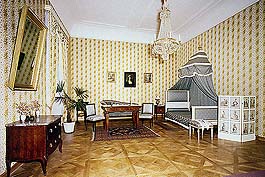19th century Suite
The Suite is furnished in a fashion typical of the beginning of the 19th century, when the Schwarzenbergs occupied the Castle. The first room of the Apartment is the Entrance Hall, which was created by connecting an area of the original tower dating from the Middle ages, with a snake-like staircase, and an annex from the 18th century. The decor and furnishings of the interior give us some idea about the way people lived at the beginning of the 19th century. In fact, we are actually in the room once inhabited by a chambermaid, so we should really expect a very modest type of accommodation.
The Music Salon, with its classicist-style furniture, textile wall coverings in the fashion of its period, and a collection of musical instruments represents a formal area used for friendly meetings and practising music in small groups. This noble entertainment was very popular at the beginning of the 19th century. At that time we know about a young oboe player, Jan Vent, working for the Schwarzenberg family, who transcribed a number of melodies from Wolfgang Amadeus Mozart\'s operas.
The interior of the Duchess Pauline zu Schwarzenberg\'s Bedroom is surprising in its combination of classicist and Biedermeier styles. The authenticity of this interior is proven by a watercolour painted by Marie Staubmann from 1841, and the modesty of the furnishings can be explained by the private character of the Apartment.

|

|
The following two rooms, once used as guest bedrooms, are typical examples of the interior of the second half of the 19th century. It is the combination of furniture of different periods and the returns to various historical styles that are so typical of this period. We should pay particular attention to the tapestries, ordered from Brussels in 1640, by the great art lover, Johann Adolf I zu Schwarzenberg (1615-1638).
(mh)

